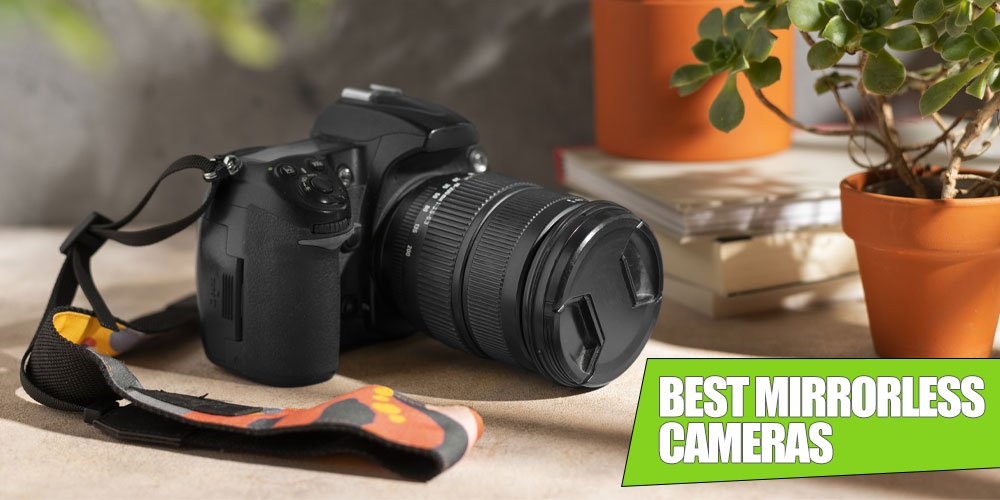
Mirrorless cameras are the latest and most advanced digital photography technology in today’s market. They offer an advantage over traditional DSLR cameras by being smaller, lighter, and more versatile.
With the emergence of mirrorless cameras in India, photographers have access to a range of options for capturing high-quality images with minimal gear.
From entry-level models to professional-grade systems, this guide is your go-to resource for finding the best mirrorless camera in India.
We’ll review some of the top models available on the market, their features and specifications, as well as discuss how they compare against each other.
So whether you’re just starting out or looking to upgrade your current DSLR, this guide will help you find the perfect fit!
Top Mirrorless Cameras Comparison For 2025
Top 10 Best Mirrorless Camera Reviews

Sony Alpha ILCE-6400L
Features
- Resolution: 24.2MP
- Form Factor: Mirrorless
- Viewfinder: Optical
- Display size: 3 Inches
The Sony Alpha ILCE-6400L is one of the top mirrorless cameras on the market today. It offers performance that rivals many of its DSLR competitors but with a much smaller and lighter form factor.
The camera is equipped with a 24.2 megapixel APS-C Exmor CMOS Sensor, producing stunning images in light and dark conditions. To complement this powerful sensor, it also features a BIONZ X image processor, which sharply reduces noise levels and accelerates speed for fast shooting, up to 11 fps, with continuous autofocus (AF) tracking.
As well as this, the Alpha ILCE-6400L includes an OLED Tru-Finder EVF, which enables precise focusing, and an XGA OLED Tru-Finder, which provides a large, bright viewfinder to check focus and exposure settings quickly and accurately. Furthermore, the Sony Alpha ILCE-6400L has a wide range of features to help you capture the perfect photo, including Eye AF for accurate subject recognition, 4K movie recording for incredibly high-resolution video, and an autofocus system with 425 phase-detection points.
The combined 16-50mm Power Zoom Lens kit is the ideal companion for the Sony Alpha ILCE-6400L Mirrorless Camera. This lens kit includes a versatile, variable-speed power zoom lens designed specifically for APS-C bodies and can cover focal lengths from 16mm to 50mm. This lens is constructed from 11 elements in 8 groups with two aspherical surfaces and an ED (extra-low dispersion) element to reduce chromatic aberrations. The lens also features a Silent Wave Motor, which ensures smooth, silent autofocusing and has a maximum aperture of f/3.5-5.6 for excellent all-around performance in low-light conditions.
The 16-50mm Power Zoom Lens kit also includes a lens hood that helps reduce flare, ghosting, and other optical aberrations. Additionally, the lens is dust and moisture-resistant, so you can take it outdoors without worrying about damage from bad weather conditions. Finally, this lens kit is compatible with Sony E-mount lenses for further creative options. With all these features combined, it is no wonder why the Sony Alpha ILCE-6400L is considered one of the best mirrorless cameras on the market today.
Pros
- 24 MP APS-C Exmor CMOS Sensor
- Fast hybrid autofocus system with 425 phase-detection AF points
- 4K video recording capabilities
- 11 fps continuous shooting speed
- Wi-Fi and NFC connectivity
Cons
- Lack of dual card slots
- No headphone jack for audio monitoring during video recording
- Limited lens selection compared to other mirrorless cameras on the market.
- No weather sealing or environmental protections.

Canon EOS R10
Features
- Resolution: 24.2MP
- Form Factor: Mirrorless
- Viewfinder: Electronic
- Display size: 3 Inches
The Canon EOS R10 is a premier digital camera that combines the latest technology with a classic design. Featuring a 24.2 MP full-frame CMOS sensor, this model can capture stunningly detailed images, even in low-light scenarios. The advanced DIGIC 8 processor enables fast, accurate autofocus and allows you to capture 4K video up to 30fps. You’ll also be able to record slow-motion footage at 120fps in Full HD resolution.
The EOS R10’s LCD is perfect for quickly navigating menus and accessing settings. It can also be used for touch focusing, which makes tracking your subject a breeze. Additionally, the camera includes Canon’s Dual Pixel CMOS AF system for incredibly fast autofocusing and excellent tracking performance even when shooting with shallow depth of field lenses. The camera’s body is dust and weather-sealed, so it can handle tough conditions without missing a beat.
For those who want complete control over their images, the EOS R10 provides a range of features to ensure that no detail goes unnoticed. You can adjust the ISO, white balance, and exposure compensation with the intuitive controls on the camera’s body or through Canon’s Image Transfer Utility app. Additionally, there is a built-in intervalometer for capturing time-lapse sequences and HDR video capabilities. Whether you’re shooting wildlife or portrait photography, the Canon EOS R10 has what you need. With its robust feature set and stylish design, it’s sure to be a camera that will be enjoyed for years.
Pros
- 24.2MP full-frame CMOS sensor, capable of capturing high-resolution and detailed imagery
- Dual Pixel CMOS AF system with 5,655 selectable points for fast and accurate autofocus performance
- High-speed shooting up to 15 frames per second continuously
- 4K UHD video recording at 30 or 24 fps in both MP4 and MOV formats
- Built-in Wi-Fi and Bluetooth technology for wireless image transfer and remote camera control
- Fully articulating touchscreen LCD monitor with 1.62 million dot resolution for easy composition adjustment when shooting from unconventional angles
Cons
- Single SD card slot supports only UHS-II cards
- Limited native lens selection, although an adapter is available to use EF and EF-S lenses with the camera
- Slightly larger and heavier than similar mirrorless cameras in its class
- Battery life is limited compared to other mirrorless cameras on the market.
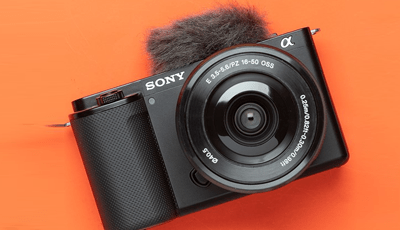
Sony Alpha ZV-E10L
Features
- Resolution: 24.2MP
- Form Factor: Mirrorless
- Viewfinder: Electronic
- Display size: 3 Inches
Introducing the Sony Alpha ZV-E10L Mirrorless Camera! The perfect combination of portability and power, the ZV-E10L is an ideal choice for serious photographers and filmmakers. Boasting an Exmor CMOS sensor with 24.2 MP resolution, this camera provides stunning image quality even in low light conditions. With its fast-focusing system and advanced BIONZ X processor, you can capture sharp images quickly and easily. Additionally, its E-mount offers compatibility with many lenses depending on your needs, further expanding its versatility.
The ZV-E10L also features a 4K video recording for stunning results. With an advanced XAVC S4 codec and a host of picture profiles, you can easily capture cinematic-quality footage. Other features of the ZV-E10L include an Eye AF mode that allows you to lock onto the subject’s face with precision autofocus and 10fps shooting speed, so you never miss any action shots. The camera also offers dual slots for SDXC memory cards, allowing you to record in different formats or simultaneously capture backup files.
For connectivity purposes, the ZV-E10L is equipped with Wi-Fi, NFC, and Bluetooth capabilities, so you can conveniently share your work with anyone, anywhere. It also features USB Type C for faster transfer speeds and an HDMI port for easy connection to external monitors or televisions. Also, The ZV-E10L features an ergonomic design that makes it comfortable to hold and use. Its features include a 3″ LCD for easy viewing and a built-in microphone, headphone jack, and external mic input for audio recordings while recording your vlogs.
Pros
- 24.2-megapixel resolution for stunning image quality
- 3.0 inch LCD touchscreen display with tiltable viewfinder
- 4K video recording ability at up to 30 fps
- Built-in stereo microphone and headphone jack
- Fast Hybrid autofocus system that can capture fast-moving subjects easily
- Wi-Fi/NFC connectivity allowing for remote operation and file sharing
Cons
- Limited lens selection due to the Sony E mount system compatibility
- No weather sealing on the body or lenses, which may limit outdoor use in harsh conditions
- Battery life is only rated at 350 shots per charge, which can drain quickly when shooting video or using Wi-Fi/NFC features
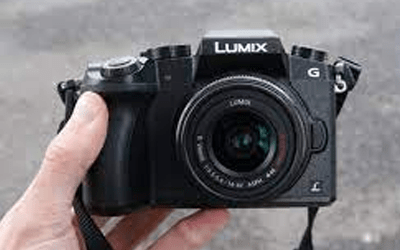
Panasonic LUMIX G7
Features
- Resolution: 16MP
- Form Factor: Mirrorless
- Viewfinder: Electronic
- Display size: 3 Inches
The Panasonic LUMIX G7 is a solid entry-level mirrorless camera with 4K video recording capabilities and a 16-megapixel sensor. It has an ISO range of 100-25600. This allows users to capture high-quality images in dimly lit environments. It also offers manual exposure settings and high-speed burst shooting, perfect for capturing fast action shots. Additionally, the G7 has advanced features like time-lapse shooting, focus peaking, Creative Control Filters, and 4K Photo Modes for capturing the perfect shot.
The G7 also features a variety of functions, such as an electronic viewfinder, a 3″ tilting LCD touch screen, and fast autofocus performance. Its dual image stabilization system helps reduce camera shake in both photos and videos for better image quality. It also has built-in Wi-Fi connectivity, allowing you to share your pictures and videos with friends and family instantly.
The Panasonic LUMIX G7 comes with a 14-42 mm lens kit. This lens is great for capturing wide-angle shots and zoomed-in details. It has an aperture of f/3.5-5.6, allowing users to control the amount of light coming into the camera for precise exposure settings. The lens also has a maximum magnification of 0.2x, enabling it to capture close-up shots with great detail. Overall, this camera is perfect for beginner photographers and videographers looking to improve their skills.
Pros
- Best Budget Mirrorless Camera in this price Range
- Compact and lightweight design for easy portability
- 4K video recording capabilities
- 16 megapixel Micro Four Thirds sensor captures stunningly detailed images
- Built-in Wi-Fi allows for wireless shooting and sharing of photos and videos
- Built-in flash for low-light shooting
- Fast autofocus system with 49 point AF points for precise focus tracking
Cons
- No weather sealing or dust protection
- Limited touchscreen functionality
- Low light performance is not as good as some competitors.
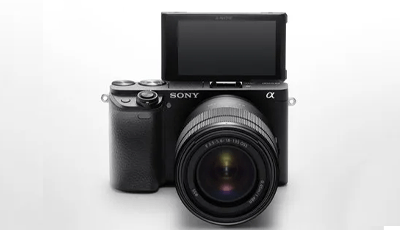
Sony Alpha ILCE-6400M
Features
- Resolution: 24.2MP
- Form Factor: Mirrorless
- Viewfinder: Optical
- Display size: 3 Inches
With The 24.2 megapixel APS-C Exmor™ CMOS sensor, this camera creates stunningly detailed images in both stills and video. In contrast, the BIONZ X™ image processing engine ensures fast and accurate focusing with an incredibly wide range of settings to choose from. With 4K movie recording capabilities, you can capture sharp, cinematic footage that will look great on the big screen or your display. Additionally, this camera features 5-axis optical SteadyShot stabilization to help keep your shots free of blurring or shaking during handheld shooting scenarios.
The Sony Alpha ILCE-6400M offers an expansive ISO range of 100 to 32000, allowing you to capture vivid, clear images even in low light conditions. Combined with the camera’s 2x optical zoom capability, you can get great close-up shots while maintaining image sharpness and clarity. Additionally, this camera supports up to 11fps continuous shooting, allowing you to capture fast-moving subjects easily.
This camera comes with a combined 18-135mm Power Zoom Lens, providing you with an amazing range of focal lengths. This lens covers everything from wide-angle shots to telephoto zooming, giving you plenty of flexibility in shooting landscapes, portraits, and more. The lens also features 11 circular aperture blades for beautiful background blur effects and smooth bokeh, allowing you to take creative photos. Additionally, the lens is equipped with Optical SteadyShot image stabilization technology for blur-free results even when shooting handheld or in low light conditions.
Pros
- 24.2MP Exmor APS-C CMOS Sensor and BIONZ X Image Processor
- Fast Hybrid Autofocus System with 425 Phase and Contrast Detection Points
- 2.36m-Dot OLED Tru-Finder EVF with 120 fps Refresh Rate
- UHD 4K30p Video with HLG & S-Log3 Gamma, plus Slow & Quick Motion
- 3.0″ 921.6k-Dot Tilting Touchscreen LCD Monitor
- Built-In Wi-Fi and Bluetooth Connectivity for Direct Sharing and Remote Control
- ISO 100–32000 (Expandable to ISO 102400)
Cons
- Menu structure is not intuitive, especially for beginners.
- Electronic viewfinder options are limited compared to full-frame models.
- Lacks 4K/60P Video Recording capabilities
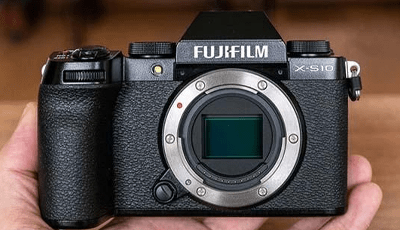
Fujifilm X-S10
Features
- Resolution: 26.1MP
- Form Factor: Mirrorless
- Viewfinder: Electronic
- Display size: 3 Inches
The Fujifilm X-S10 has an APS-C-sized 26.1MP X-Trans CMOS 4 sensor, which captures high-resolution images with outstanding sharpness and minimal noise. The camera also produces outstandingly accurate colors, thanks to its X-Processor 4 processor and the FUJINON Lens X mount system.
For superior autofocus performance, the Fujifilm X-S10 Mirrorless Camera features 425 phase-detection AF points and face/eye detection for both people and animals. The camera also includes 8fps continuous shooting with a mechanical shutter or 30fps with an electronic shutter for capturing fast-paced action. Additionally, 4K UHD video recording is available at 30fps, and DCI 4K video recording is available at 24fps.
The Fujifilm X-S10 Mirrorless Camera also features a 3.0″ 1.04M-dot LCD touchscreen that tilts up to 180° and down by 90°, providing versatility when shooting from different angles. The camera also has dual SD card slots that support both UHS-II and UHS-I cards for expanded storage options, as well as a USB Type-C port that supports charging the camera’s battery while in use or live streaming directly to an external monitor or projector via HDMI without the need of an additional device.
In short, the Fujifilm X-S10 Mirrorless Camera is a feature-packed camera that delivers professional results with every shot. Whether you are a professional photographer or just getting started, this camera will meet your needs and exceed your expectations.
Pros
- Lightweight and compact design
- Fast autofocus and tracking performance
- Range of creative video features, including 4K/30p recording
- Excellent image quality with high-resolution 26.1MP X-Trans CMOS IV sensor
- In-body stabilization to reduce camera shake in stills and videos
Cons
- Smaller EVF than some other mirrorless cameras
- Limited buffer depth for continuous shooting
- Unimpressive battery life compared to competitors
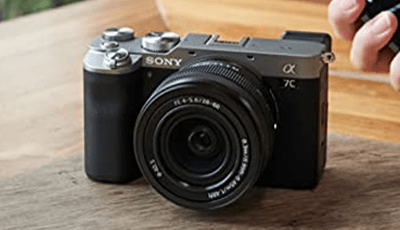
Sony Alpha ILCE-7CL
Features
- Resolution: 24.2MP
- Form Factor: Mirrorless
- Viewfinder: Electronic
- Display size: 3 Inches
The Sony Alpha ILCE-7CL camera features a 24.2MP full-frame Exmor R CMOS image sensor for stunningly detailed images and an advanced BIONZ X image processing engine for fast, accurate rendering. It also offers up to 10 frames per second shooting capacity with continuous AF/AE tracking, perfect for capturing fast-moving subjects. Additionally, the camera has various advanced features like 5-axis image stabilization, 4K movie recording with full pixel readout and no pixel binning, and a range of lens mount adapters for exceptional flexibility.
This camera’s slim and ergonomic design makes it ideal for carrying around all day without feeling weighed down. It also boasts an impressive battery life, capturing up to 650 still images on one charge, perfect for extended shooting sessions. And with its magnesium alloy body construction, the camera is durable and resistant to dust and moisture, so you don’t have to worry about damaging your equipment.
The Sony Alpha ILCE-7CL Camera comes with a combined 28-60mm F4-5.6 Zoom Lens, giving you the versatility to capture stunning shots in any situation. Additionally, this camera offers compatibility with a wide range of lenses from Sony and other third-party manufacturers, including E-Mount and A-Mount lenses. This gives you an incredible selection of lens options, so you can always get the perfect shot. With its advanced sensor and processing engine, fast shooting speed, and durable construction, this camera is a must-have for any photographer looking to take their photographic artistry to the next level.
Pros
- 24.3MP full-frame Exmor CMOS sensor for excellent image quality
- High ISO sensitivity settings up to 51200 for detailed low-light images
- 4K video recording with full pixel readout and no pixel binning
- Built-in 5-axis in-body stabilization for steadier shots
- Fast Hybrid AF system with 693 phase-detection points for quick autofocus
- Durable magnesium alloy body is dust, moisture, and cold resistant
- OLED electronic viewfinder with 2,359k dot resolution
Cons
- Expensive relative to other full-frame cameras
- No built-in flash and no hot shoe for an external flash unit
- Only one UHS-II compatible memory card slot
- Menu system can be complicated to use at first

Nikon Z6 Mark II
Features
- Resolution: 24.5MP
- Form Factor: Mirrorless
- Viewfinder: Digital
- Display size: 3.2 Inches
The Nikon Z 6II features 24.5 megapixels of resolution, allowing for detailed images and vibrant colors. The camera has an increased autofocus system with 273 points of coverage, allowing you to capture sharp shots in any situation. In addition, it includes the latest technologies, such as 5-axis in-body stabilization and dual EXPEED 6 image processors that work together to deliver 4K/UHD video recording at 30 frames per second. With its advanced features, you can take advantage of high-speed shooting to create dynamic results even when shooting on the go.
The Nikon Z 6II mirrorless camera is designed to be both lightweight and durable. The body is constructed from magnesium alloy, making it highly resistant to damage while keeping the weight low. The controls are ergonomically placed for easy access, and the 3.2-inch LCD monitor can be tilted up or down for added convenience. The camera also features a weather-sealed design that protects against dust, moisture, and other environmental elements. This ensures that your images remain sharp and beautiful no matter where you take them. In addition, all of the buttons on the camera have a textured surface, making them easier to use even when wearing gloves.
The Combined Z 24-70mm f/4 Lens is a powerful and versatile lens that is perfect for any photographer. This lens offers a wide zoom range, from 24 to 70mm, allowing you to capture everything from sprawling landscapes to detailed close-ups. With an aperture of f/4, this lens allows for bright images even in low-light situations. Additionally, the optical design features two ED glass elements and three aspherical elements, which work together to reduce chromatic aberrations and deliver crisp images with true color accuracy.
Pros
- 24.5MP resolution image sensor with EXPEED 6 image processor
- Dual EXPEED 6 processors for improved performance and low noise
- 4K Ultra HD video recording at up to 30 frames per second
- Autofocus system with 273 AF points, Eye Detection AF, and Deep Learning algorithms for excellent accuracy
- Up to 14 fps continuous shooting with full autofocus in burst mode
- Wi-Fi and GPS connectivity for quick sharing and controlling the camera remotely
- UHS-II compatible card slot for fast data transfer speeds
- Weather-sealed body design for use in harsh conditions
Cons
- Relatively limited battery life compared to other cameras in its class
- No built-in flash
- High ISO performance not as good as some competitors
- No built-in flash
- Not compatible with older non-Nikon lenses due to the lack of an optical adapter
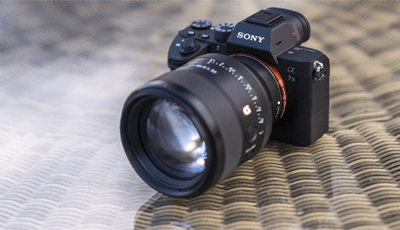
Sony a7 III
Features
- Resolution: 24.2MP
- Form Factor: Mirrorless
- Viewfinder: Electronic
- Display size: 3 Inches
The Sony a7 III is an impressive full-frame mirrorless camera that packs a lot of features into its compact design. It has a 24.2-megapixel resolution, a backside illuminated full-frame image sensor for improved low-light performance and autofocus capabilities and fast hybrid autofocus with 693 phase-detection points that cover 93% of the frame. This camera also features 4K video recording capabilities and 120 fps slow motion capture in full HD.
The body offers 5-axis stabilization to reduce shaking while shooting and dust and moisture resistance for outdoor use. Additionally, the Sony A7 III comes with an AF joystick for quickly selecting focus points, a top LCD screen for easily changing settings or checking battery life, and an extensive battery life of up to 710 shots on one charge.
It has a weather-sealed magnesium alloy body that is dust and moisture-resistant, making it ideal for outdoor use. The camera also features dials and buttons that are easy to access and use, even when wearing gloves or shooting in the dark. Furthermore, its grip is designed for comfort and convenience, allowing it to fit securely in hand during long photo shoots. Finally, the shutter unit is tested for up to 200,000 cycles. With all of these features combined, you can rest assured that your Sony a7 III can withstand the rigors of professional photography.
The Sony a7 III offers extensive connectivity options. It has built-in Wi-Fi and NFC, making it easy to connect with smartphones or tablets. Additionally, the camera features a USB Type-C port for faster file transfers and an HDMI output for connecting to external monitors and TVs. The Sony A7 III also has a microphone input and headphone jack for recording audio or monitoring sound levels during video recording. Finally, this camera supports XQD or SD cards for storing photos and videos. With these connectivity options, you can be sure that you’ll be able to share your work quickly and easily while on the go.
It also comes with various accessories that make it even more versatile. The camera can add other lenses like telephoto or wide-angle zoom lenses, as well as adapters for using non-native glassware. Additionally, you can use the Multi-Interface Shoe to add external flashes or microphones. And if you’re looking to enhance your photography experience even further, the Sony A7 III can be used with many different software applications such as Capture One Pro or Lightroom CC.
Pros
- 24.2MP full-frame back-illuminated Exmor R™ CMOS image sensor for impressive detail and clarity
- Fast Hybrid AF with 693 phase-detection and 425 contrast autofocus points quickly locks onto subjects
- Improved Eye AF to track and lock onto human eyes more efficiently
- Up to 10fps continuous shooting at full resolution with AE/AF tracking
- 5 axis optical in-body image stabilization system compensates for five types of camera shake
- 4K video recording with no pixel binning for stunningly high-quality footage
- Durable, dust and moisture-resistant design makes shooting in any environment easier
Cons
- Expensive compared to similar models from other manufacturers
- No built-in flash or hot shoe for external flash units
- Menu navigation can be overly complex for some users
- Single memory card slot limits storage capacity and backup options
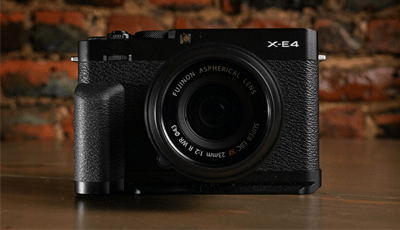
Fujifilm X-E4
Features
- Resolution: 26.1MP
- Form Factor: Mirrorless
- Viewfinder: Electronic
- Display size: 3 Inches
The Fujifilm X-E4 Mirrorless Camera is the latest in the X-Series lineup and provides professional-quality images. The compact body of the camera has a number of features that allow it to match some of the more expensive models on the market, making it an ideal choice for both professionals and enthusiasts alike.
This mirrorless camera uses an APS-C-sized sensor, allowing for high-resolution images with minimal noise. It also offers a wide range of ISO settings from 100 to 51200, giving you greater control over your photos in low-light conditions. The autofocus feature is extremely accurate and fast, making it easy to capture sharp images quickly. With multiple focus points, you can easily select specific areas to focus on for detailed shots.
The Fujifilm X-E4 features a tilting touchscreen LCD, making it easy to compose your images and shoot from different angles. It also has an electronic viewfinder which gives you a clear, high-contrast image with accurate color reproduction. The camera can also record 4K video at 30 fps and 1080p video at 120 fps for slow-motion videos.
The Fujifilm X-E4 Mirrorless Camera is the perfect companion for any photographer looking for a versatile and powerful camera without compromising on quality. With its wide selection of lenses, manual controls, and reliable autofocus system, the X-E4 will give you stunning results no matter what type of photography you are into. Whether you are shooting landscapes, portrait photography, sports, or action shots, the Fujifilm X-E4 will give you excellent results every time.
Pros
- Compact and lightweight design, great for travel photography
- High quality 24.3 megapixels APS-C X-Trans CMOS 4 sensor
- Fast autofocus speed with 425 AF points to capture quick action shots
- Supports advanced video recording formats up to 4K/30p for high-definition footage
- Includes 15 film simulations and 11 advanced filters for artistic effects
- Built-in Bluetooth and Wi-Fi connectivity allows easy sharing of photos and videos over the web
Cons
- No built-in image stabilization feature
- Expensive compared to other entry-level mirrorless cameras on the market.
- No Weather sealing, making it vulnerable to dust and moisture
Crucial Factors to Consider before buying a Mirrorless Camera
Mirrorless cameras are the perfect choice for those looking to step up their photography game. With advanced features and a smaller form factor, they offer a unique blend of convenience and performance that makes them attractive to amateur photographers and professionals. Before you make your purchase, however, there are a few factors you should consider in order to ensure that you get the most out of your investment.
1. Brand
When buying a mirrorless camera, the first factor to consider is the brand. Some of the more popular brands in this category are Sony, Canon, and Nikon. Each brand has its strengths and weaknesses. For instance, Sony cameras have excellent autofocus performance and wide lens selection, while Canon cameras offer superior image quality and ergonomics.
2. Sensor Size
Sensor size is a key factor in determining image quality. Generally speaking, the larger the sensor size, the better the image quality. However, larger sensors tend to be more expensive and require bigger lenses. Smaller sensors provide lower image quality but are often more affordable and can use smaller lenses.
3. Lens selection
Mirrorless cameras usually offer greater lens selection than traditional DSLRs because they are not subject to the same space constraints due to their compact design. This allows more lenses to be used with the camera, giving you more flexibility and options.
4. Autofocus
Autofocus speed is an important factor to consider when choosing a mirrorless camera, as this will impact how quickly and accurately your camera can focus on subjects. Some cameras have faster-autofocusing systems than others, so it’s important to research before deciding which one is right for you.
5. Battery Life
Battery life can be an issue with some mirrorless cameras, so it’s important to look at how long the battery life is in each model you are considering. Make sure that the battery life is sufficient for your needs so that you don’t run out of power in the middle of a shoot.
6. Weight and Size
Mirrorless cameras are generally smaller and lighter than DSLRs, so it’s important to consider how the weight and size will affect your ability to use the camera comfortably. If you plan on carrying the camera around all day or traveling with it, make sure that it is not too bulky or heavy for you.
7. Video Quality
Many mirrorless cameras offer excellent video capabilities, but some models may have better quality than others. If you intend to use your camera for videography, check what video resolutions and frame rates each model offer to get the best possible quality from your footage.
8. Connectivity
Many mirrorless cameras offer Wi-Fi and NFC connectivity, making it easier to quickly transfer images and videos to other devices or share them online. Look for models with built-in wireless capabilities, so you don’t have to rely on an external device for connectivity.
9. Accessories
Camera accessories are a great way to get the most out of your camera, but check what accessories are compatible with each model you are considering before making a purchase. This will help ensure that you have the tools and equipment to maximize your enjoyment of photography.
10. Budget
It’s important to consider your budget when purchasing a mirrorless camera. Consider what features and capabilities you need, as well as the cost of those features and accessories, before deciding so that you can get the most bang for your buck.
FAQs: Frequently Asked Questions About Mirrorless Cameras
Are mirrorless cameras as good as DSLRs?
It depends on the model and brand, but mirrorless cameras generally offer comparable image quality to DSLRs. They have smaller bodies and lenses but can produce similar results as DSLRs when used properly.
Do mirrorless cameras use battery power more quickly than DSLRs?
Yes, this is true due to the electronic viewfinder and extra features such as Wi-Fi, Bluetooth, and 4K video. A mirrorless camera will typically use more battery power than a DSLR. However, newer mirrorless camera models are more efficient with battery usage.
Are there any advantages of using a mirrorless camera over a DSLR?
Yes, there are several advantages. Mirrorless cameras typically have smaller and lighter body designs, making them more portable than DSLRs. They also offer a wider range of features, such as advanced autofocus, 4K video recording, and built-in Wi-Fi and Bluetooth connectivity. Some mirrorless camera models can also shoot at faster shutter speeds than DSLRs.
Do professional photographers use mirrorless cameras?
Yes, many professional photographers use mirrorless cameras for their projects. Mirrorless cameras offer a wide range of features and image quality comparable to DSLRs. Additionally, they are usually lighter and more portable than DSLRs, making them perfect for on-the-go shooting.
Are there any drawbacks to using a mirrorless camera?
The main drawback is that some types of lenses available for DSLRs are not compatible with mirrorless cameras. Additionally, the battery life is typically shorter on mirrorless cameras than on DSLRs. Finally, some photographers may find it difficult to adjust their shooting habits when switching from a DSLR to a mirrorless camera.
Are there any special tips for using a mirrorless camera?
There are several tips to get the most out of your mirrorless camera. Make sure you familiarize yourself with all the features before shooting, as this will help you maximize your camera’s capabilities and get the desired results. Also, keep your camera and lenses clean from dust and dirt to ensure optimal image quality. Finally, ensure you use the correct settings for different types of photography to get the best results.
Are there any specific accessories I should get for my mirrorless camera?
Yes, there are several accessories you should consider getting for your mirrorless camera. These include extra batteries, memory cards, flash units, filters, remotes, and lens adapters. These accessories are designed to help enhance your shooting experience and can take your photography to the next level.
Which is generally better, Sony or Fujifilm mirrorless cameras?
This is a difficult question, as Sony and Fujifilm are popular brands with excellent mirrorless cameras. Ultimately, it comes down to personal preference, budget, and the type of photography you plan on doing. Be sure to research before making a purchase and consider the different models available from each brand.
Is the iPhone 15 Pro camera better than a normal mirrorless camera?
The iPhone 14 Pro has an impressive camera, but it still cannot match the quality and features of a dedicated mirrorless camera. Mirrorless cameras typically offer better image quality, more advanced autofocus capabilities, and higher resolution video recording than smartphones.
Conclusion: So, Best Mirrorless Camera?
After reviewing and researching the best mirrorless camera, it is clear that each model offers a great set of features and capabilities.
From Sony’s Alpha series to Panasonic’s Lumix to Canon’s EOS M range, there are various choices available for photographers who wish to take their craft to the next level without sacrificing quality or performance.
Each camera has unique advantages, so photographers must weigh their options carefully when choosing the best model for their needs.
By taking advantage of the various features available in these high-quality mirrorless cameras, photographers can capture stunning images with ease and confidence.
Important Article
